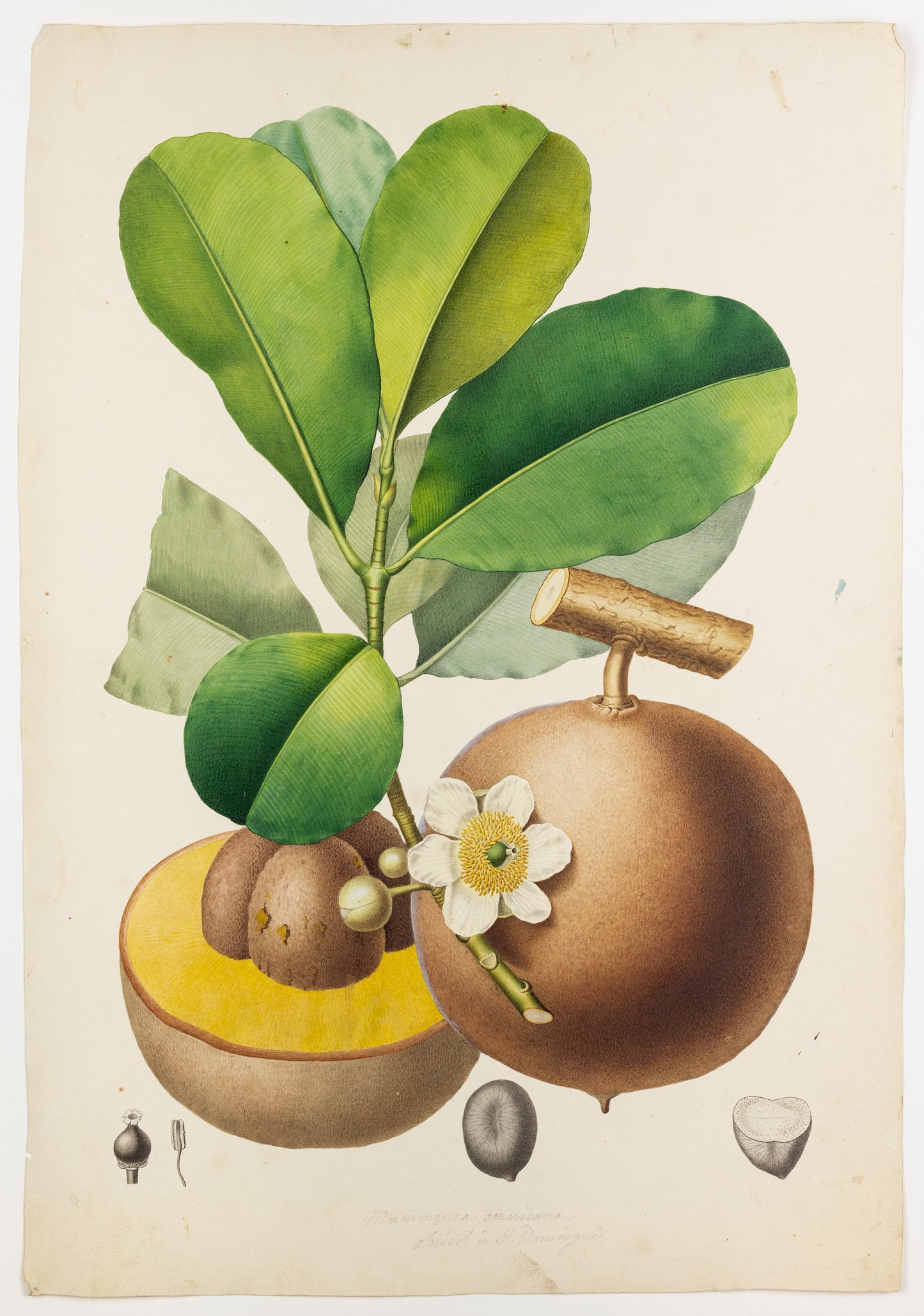from: Poiteau & Turpin Superb Botanical Drawings including varieties from the West Indies
PIERRE JEAN FRANÇOIS TURPIN (FRENCH, 1775 - 1840). Mammee apple tree. 1808-1827.
PIERRE JEAN FRANÇOIS TURPIN (FRENCH, 1775 - 1840). Mammee apple tree. 1808-1827.
Couldn't load pickup availability
PIERRE JEAN FRANÇOIS TURPIN (FRENCH, 1775 - 1840)
“Mammea Americana abricot de St. Domingue”
(Mammea Americana. Gallis, Mamei Damerique. Mammee Apple or Santo Domingo Apricot)
Preparatory drawing for F.R. Tussac. Flore des Antilles, ou histoire générale botanique, rurale et economique des végétaux indigènes des Antilles.
Paris: chez l’auteur, F. Schoell et Hautel, 1808-1827 Vol 3 Pl. 7
Watercolor, ink, and pencil on paper
Inscribed “Mammea Americana abricot de St. Domingue”
Paper size: 17 1/2 x 12 1/4 in. Frame size: 24 3/8 x 18
The mammee apple tree is native to the Caribbean and is also widely cultivated in Central America and the tropics. In Haiti, it is known as zabriko or abricot. It was first mentioned in Oviedo’s Review of the Fruits of the New World in 1529. Over time, it was introduced to various regions in the Old World, such as West Africa, Sierra Leone, Zanzibar, Southeast Asia, and Hawaii. In the United States, the mammee apple is found only in Hawaii and Florida. In Florida, it was most likely introduced from the Bahamas.
The fruit’s raw flesh can be served in fruit salads or with wine, sugar, or cream, especially in Jamaica. In the Bahamas, the flesh is first soaked in salted water to remove its bitterness, then cooked with lots of sugar to make a type of jam. The flesh can also be consumed stewed.
In the French West Indies, the mammee flowers are used to distill an aromatic liqueur known as “eau créole” or “crème créole.” This liqueur is believed to be tonic or digestive.
Tussac described this tree as: “The mamei, commonly apricot tree from Santo Domingo, must be placed among the most beautiful trees that nature has graced the Antilles… The tree commonly known in the West Indies, where it is native, under the name of apricot tree, cannot fail to be noticed by travelers who have to cross the little woods that escape the ambitious control of the Europeans; its presence is announced from afar by the delicious aroma that its flowers spread throughout the atmosphere, and the density of its beautiful foliage, which cannot be penetrated by the burning rays of the sun, invites us…
The first Europeans who settled in Saint-Domingue gave the fruit the name of abricot, having found in its color, its smell, and even in its taste, a similarity with apricot of Armenia… The Creole ladies of the West Indies make a lot of meals from the fruits of the mamei. They eat them in several ways, the most common of which consists of removing the skin, which is very thick, so that no part of it remains, because it would impart an unpleasant bitterness to the pulp; we must also not cut this pulp too close to the stones, without running the risk of the same inconvenience; this double precaution taken, we can eat this fruit with pleasure when it is ripe.
However, you must watch your stomach, because it is very indigestible; it becomes less so when, after having cut it into thin slices, it is macerated for several years in Bordeaux wine, better still Madeira, and adding a little sugar. The healthiest and most generally adopted way consists of making a semi-sweet marmalade or compote with this fruit, to which we add a few cloves, a few zest of lemon peel. This marmalade can be compared in goodness and healthiness to that of Armenian apricots.
The Spaniards, colonists of Cuba, generally very fond of all kinds of preserves, make a kind of marmalade with the pulp of the mammei into which they add ginger and different spices; after juicing the oranges, they fill the skin with this composition, and they dry them in an oven. They rarely fail to eat this type of dried jam after their meal, in the belief that it greatly facilitates digestion, which I am led to believe. It is with the flower of this beautiful mamei tree that Madame Amphoux (a famous French distiller), justly famous in the art of composing liqueurs, made the one she called eau creole.”

Appeared in F.R. Tussac. Flore des Antilles, ou histoire générale botanique, rurale et economique des végétaux indigènes des Antilles.
Paris: chez l’auteur, F. Schoell et Hautel, 1808-1827 Vol 3 Pl. 7


